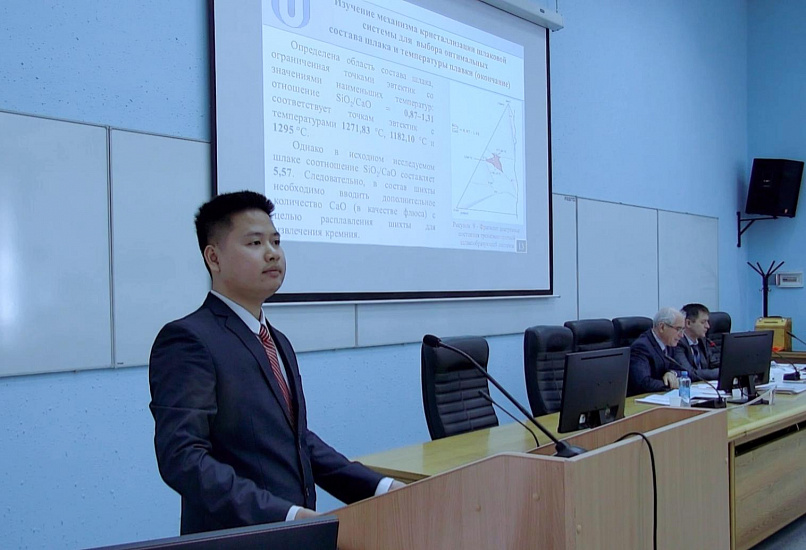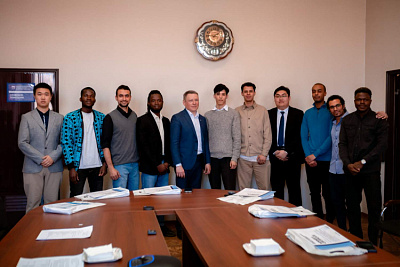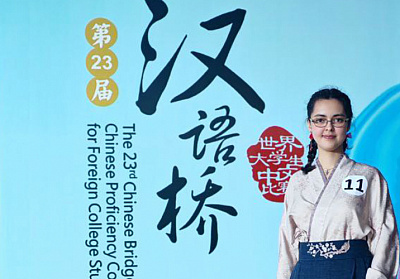Extract Silicon as Silumin from Refinery Slag, a Method Developed by Hoang Van Vien, PhD Student of INRTU
Hoang Van Vien, PhD student of the Department of Metallurgy of Non-ferrous Metals of INRTU, successfully defended his PhD thesis. The author has created an innovative technology of extraction of silicon in the form of silumin from refinery slag, technogenic raw materials of silicon production. The project is important for metallurgy and ecology.
The defense was held in the conference hall of INRTU. The scientific supervisor of the PhD applicant was Professor Nina Nemchinova.
According to As Hoang Van Vien, the demand for metallurgical silicon (MG-Si) is growing in many industries. This element is used as an alloying additive in the manufacture of alloys and as a component for the production of chemical and semiconductor products.
MG-Si is usually produced by recovery from quartz raw materials at a temperature above 2200 °C. Thus, Kremnii, a RUSAL company, produces refined silicon. This product is obtained by refining the melt in a ladle by air blowing. During the cleaning process, technogenic waste is formed as slag containing impurity oxides and flux, as well as up to 70% of elemental silicon. This leads to a decrease in the level of production of Si. Besides, there are environmental threats since slags are stored in bulk at landfills near industrial enterprises.
To solve this issue, the PhD student started to look for an innovative way to process slag. He conducted analysis of physical and chemical properties of refined slag samples taken at Kremnii workshops. Experiments were carried out on the selection of fluxes for reducing melting point and viscosity by adding fluoride and calcium oxide.
As a result of the experiments Van Vien obtained silumin with parameters similar to those in the industrial 4043 alloy. Using the method of planning a three-factor experiment, he determined the optimal melting conditions: temperature (x1) at 1350-1400 °C. The researcher developed computer programs for the rapid calculation of slag and flux composition to process slag.
"The results of the experiments have increased the recovery of silicon in the process to ~72.2%. The proposed technology will help reduce the negative impact on ecosystems, saving steel producing companies from high costs for waste disposal. Experimental silumins can be recommended as a basis for preparation of silumins in foundy enterprises," - emphasized Van Vien.The official opponents of the PhD student were Peter Kuzmin, Doctor of Technical Sciences, Head of the Casting Department of RUSAL Engineering and Technology Center and Vladimir Bagin, DSc, Head of the Metallurgy Department of St. Petersburg Mining University.
It is interesting to note, Hoang Van Vien has been in Russia for 10 years. Having won a government scholarship in 2013, he entered the branch of the St. Petersburg Military Academy of Logistics named after A.V. Khrulev in Penza. He successfully graduated from the university, as a specialist in the field of operation of small arms, artillery and missile weapons. Then he decided to continue his postgraduate studies and chose INRTU.
During his studies at INRTU, the Vietnamese postgraduate student prepared 16 scientific articles, four of which were published in journals that were included in the Higher Attestation Commission list and one publication indexed by Scopus international database. The young researcher is the co-author of the patent on “Method of Separation of Silicon from Silicon Slag in the form of Silicon and Aluminum Alloy” and three computer programs.
The theoretical and experimental results and computer programs are of practical interest to industrial partners, and are also used in the educational process when training metallurgists at INRTU.
The graduate admits that the university provided him with all necessary facilities and modern equipment for experiments. He thanks Nina Nemchinova and Andrei Tyutrin, Associate Professor for their help in the research.
In June, Van Vien is going to defend his scientific and qualification work. Then the scientist will return to his homeland in Hanoi. He hopes that Russian education will help him find job in large Vietnamese companies, including Viet Nhat Steel Factory, Hoa Phat Steel Factory, Thai Nguyen Iron and Steel Factory.
Photos by Arseny Chekmariov and also from the archive of the PhD student









